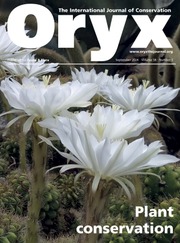No CrossRef data available.
Article contents
Status of the hog deer in Sri Lanka
Published online by Cambridge University Press: 24 April 2009
Abstract
Core share and HTML view are not available for this content. However, as you have access to this content, a full PDF is available via the ‘Save PDF’ action button.
The hog deer Axis porcinus was believed to be extinct in Sri Lanka until a recent preliminary survey revealed a single remaining population in a 35-sq-km area of the south-western coastal belt. The authors describe the results of their 3-month study, outline potential threats to the survival of the population and discuss possible conservation measures.
- Type
- Research Article
- Information
- Copyright
- Copyright © Fauna and Flora International 1994
References
Baldwin, M.F. (ed.). 1991. Natural Resources of Sri Lanka: Conditions and Trends. A report prepared for the Natural Resources, Energy and Science Authority of Sri Lanka. 280 pp.Google Scholar
Dhungel, S.K. and O'Gara, B.W. 1991. Ecology of the hog deer in Royal Chitwan National Park, Nepal. Wildlife Monograph, 119. 40 pp.Google Scholar
Green, M.J. 1985. Aspects of the Ecology of Himalayan Musk Deer. PhD. thesis. University of Cambridge, Cambridge, UK. 280 pp. (unpubl.).Google Scholar
Honacki, J.H., Kinman, K.E. and Koeppl, J.W. 1982. Mammal Species of the World: a Taxonomic and Geographic Reference. Allen Press and The Association of Systematics Collections, Lawrence Kansas, USA. 694 pp.Google Scholar
Phillips, W.W.A. 1935. Manual of the Mammals of Ceylon, pp. 333–337. Dulau and Co. Ltd, London, UK and Colombo, Sri Lanka.Google Scholar
Prater, S.H. 1980. The Book of Indian Animals. Bombay Natural History Society, Bombay, India. 324 pp.Google Scholar
Saparamadu, S.D. 1972. The hog deer: is it really extinct in Ceylon? Ceylon Wildlife Bulletin 11, 3.Google Scholar
Schaller, G.B. 1967. The Deer and the Tiger. University of Chicago Press, Chicago, Illinois, USA. 370 pp.Google Scholar
Seidensticker, J.C. 1976. Ungulate populations in Chitwan Valley, Nepal. Biological Conservation, 10, 183–210.CrossRefGoogle Scholar


